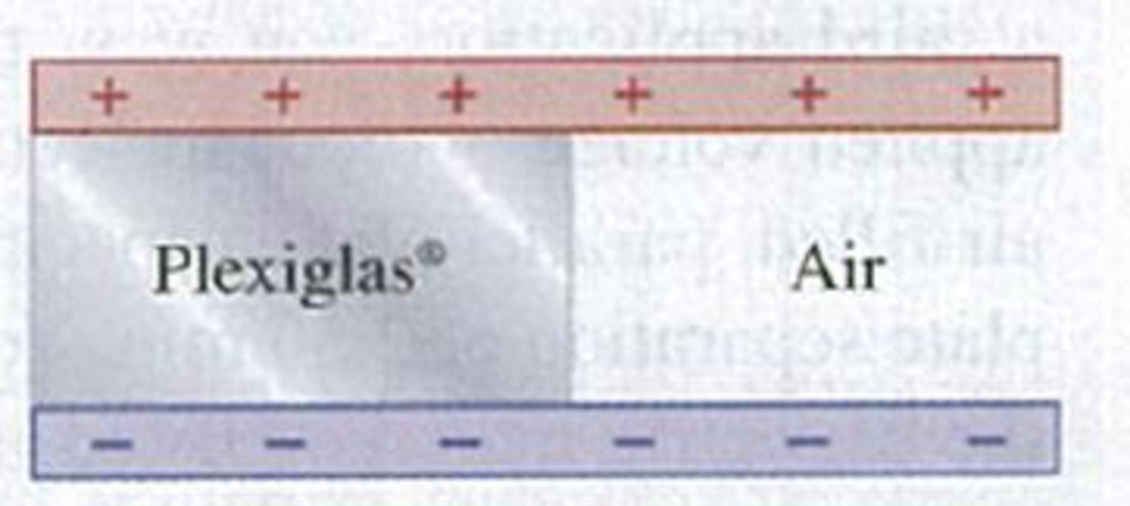
Concept explainers
A parallel-plate capacitor is made from two plates 12,0 cm on each side and 4.50 mm apart. Half of the space between these plates contains only air, but the other half is filled with Plexiglas® of dielectric constant 3.40 (Fig. P24.66). An 18.0-V battery is connected across the plates. (a) What is the capacitance of this combination? (Hint: Can you think of this capacitor as equivalent to two capacitors in parallel?) (b) How much energy is stored in the capacitor? (c) If we remove the Plexiglas® but change nothing else, how much energy will be stored in the capacitor?
Figure P24.66

Want to see the full answer?
Check out a sample textbook solution
Chapter 24 Solutions
University Physics (14th Edition)
Additional Science Textbook Solutions
Physics (5th Edition)
Physics for Scientists and Engineers with Modern Physics
Sears And Zemansky's University Physics With Modern Physics
College Physics: A Strategic Approach (4th Edition)
University Physics Volume 1
Tutorials in Introductory Physics
- A spherical capacitor is formed from two concentric spherical conducting spheres separated by vacuum. Tire inner sphere has radius 12.5 cm and the outer sphere has radius 14.8 cm. A potential difference of 120 V is applied to the capacitor, (a) What is the capacitance of the capacitor? tb) What is the magnitude of the electrical field at r = 12.6 cm, just outside the inner sphere? (c) What is the magnitude of the electrical field at r = 14.7 cm, just inside the outer sphere? (d) For a parallel-plate capacitor the electrical field is uniform in the region between the plates, except near the edges of the plates. Is this also true for a spherical capacitor?arrow_forwardAn electronics technician wishes to construct a parallel plate capacitor using rutile ( = 100) as the dielectric. The area of the plates is 1.00 cm2. What is the capacitance if the rutile thickness is 1.00 mm? (a) 88.5 pF (b) 177 pF (c) 8.85 F (d) 100 F (e) 35.4 Farrow_forwardWhat If? The two capacitors of Problem 13 (C1 = 5.00 F and C2 = 12.0 F) are now connected in series and to a 9.00-Y battery. Find (a) the equivalent capacitance of the combination. (b) the potential difference across each capacitor, and (c) the charge on each capacitor.arrow_forward
- A spherical capacitor consists of a spherical conducting shell of radius b and charge 2Q that is concentric with a smaller conducting sphere of radius a and charge +Q (Fig. P20.36). (a) Show that its capacitance is C=abke(ba) (b) Show that as b approaches infinity, the capacitance approaches the value a/ke = 40a. Figure P20.36arrow_forward(a) Find the equivalent capacitance between points a and b for the group of capacitors connected as shown in Figure P25.12 (page 686). Take C1 = 5.00 F, C2 = 10.0 F, and C3 = 2.00 F. (b) What charge is stored on C3 if the potential difference between points a and b is 60.0 V? Figure P25.12arrow_forwardAn arrangement of capacitors is shown in Figure P27.23. a. If C = 9.70 105 F, what is the equivalent capacitance between points a and b? b. A battery with a potential difference of 12.00 V is connected to a capacitor with the equivalent capacitance. What is the energy stored by this capacitor? Figure P27.23 Problems 23 and 24.arrow_forward
- What is the maximum charge that can be stored on the 8.00-cm2 plates of an air-filled parallel-plate capacitor beforebreakdown occurs? The dielectric strength of air is 3.00 MV/m.arrow_forwardFour capacitors are connected as shown in Figure P25.11. (a) Find the equivalent capacitance between points a and b. (b) Calculate the charge on each capacitor, taking Vab = 15.0 V. Figure P25.11arrow_forwardFour capacitors are connected as shown in Figure P16.48. (a) Find the equivalent capacitance between points a and b. (b) Calculate the charge on each capacitor, taking Vab = 15.0 V. Figure P16.48arrow_forward
- A parallel-plate capacitor has square plates that are 8.00 cm on each side and 3.80 mm apart. The space between the plates is completely filled with two square slabs of dielectric, each 8.00 cm on a side and 1.90 mm thick. One slab is Pyrex glass and the other slab is polystyrene. If the potential difference between the plates is 86.0 V, find how much electrical energy can be stored in this capacitor.arrow_forward(a) What is the capacitance of a parallel plate capacitor having plates of area 1.50 m2 that are separated by 0.0200 mm of neoprene rubber? (b) What charge does it hold when 9.00 V is applied to it?arrow_forwardA variable air capacitor used in a radio tuning circuit is made of N semicircular plates, each of radius R and positioned a distance d from its neighbors, to which it is electrically connected. As shown in Figure P20.38, a second identical set of plates is enmeshed with the first set. Each plate in the second set is halfway between two plates of the first set. The second set can rotate as a unit. Determine the capacitance as a function of the angle of rotation , where = 0 corresponds to the maximum capacitance. Figure P20.38arrow_forward

 Principles of Physics: A Calculus-Based TextPhysicsISBN:9781133104261Author:Raymond A. Serway, John W. JewettPublisher:Cengage Learning
Principles of Physics: A Calculus-Based TextPhysicsISBN:9781133104261Author:Raymond A. Serway, John W. JewettPublisher:Cengage Learning College PhysicsPhysicsISBN:9781305952300Author:Raymond A. Serway, Chris VuillePublisher:Cengage Learning
College PhysicsPhysicsISBN:9781305952300Author:Raymond A. Serway, Chris VuillePublisher:Cengage Learning College PhysicsPhysicsISBN:9781285737027Author:Raymond A. Serway, Chris VuillePublisher:Cengage Learning
College PhysicsPhysicsISBN:9781285737027Author:Raymond A. Serway, Chris VuillePublisher:Cengage Learning Physics for Scientists and Engineers with Modern ...PhysicsISBN:9781337553292Author:Raymond A. Serway, John W. JewettPublisher:Cengage Learning
Physics for Scientists and Engineers with Modern ...PhysicsISBN:9781337553292Author:Raymond A. Serway, John W. JewettPublisher:Cengage Learning Physics for Scientists and Engineers: Foundations...PhysicsISBN:9781133939146Author:Katz, Debora M.Publisher:Cengage Learning
Physics for Scientists and Engineers: Foundations...PhysicsISBN:9781133939146Author:Katz, Debora M.Publisher:Cengage Learning





